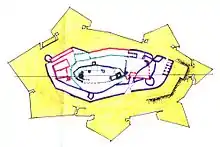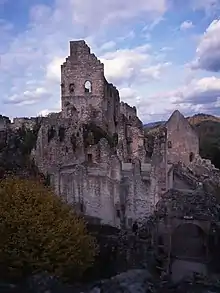Hochburg
The Hochburg ("high castle") is a castle ruin situated between the city of Emmendingen and the village of Sexau in the region of Baden, located in the southwest of Germany. It was presumably built in the 11th century and was originally known as castle Hachberg. The line of nobles known as the Margraves of Baden-Hachberg most likely derive their name from this castle and before it was razed by the French it was the second largest fortification in Baden.


The Name
Historians are uncertain about where the name Hachberg comes from. One theory is that an estate in the region was given to a man referred to as Hacho who was a part of Charlemagnes retinue. This hypothesis is also supported by an engraved plaque added to the castle by Karl II and a document dating back to 1161 mentions it as Castro Hahberc. In any case, whoever the true builder of the castle is most likely chose its name for their lineage, resulting in the family sidebranch of the house of Baden known as Baden-Hachberg.
The first mention of a transition from Hachberg to Hochberg can be found in French sources concerned with members of the lineage of Hachberg-Sausenberg, who were the counts of Neuenburg as well.
The name Hochberg sees its German revival as late as 1787, when Margrave Karl Friedrich, as second husband, married Luise Karoline Freiin Geyer von Geyersberg and made her the Imperial Countess of Hochberg.
History

The Lords of Hachberg
Dietrich von Emmendingen (who later called himself von Hachberg) most likely founded the castle to harvest the forests surrounding it for lumber. Its first mention dates back to a document from 1127. The further development of later property documents suggests that Erkenbold von Hachberg, the last of his name, gave his holdings to the Zähringer to finance his participation in the crusades (1147–1149).
The Margraves of Baden 1161-1212
A document on the talks about the founding of the monastery Tennenbach from 1161 implies that Hermann IV von Baden was the reigning lord of castle Hachberg at the time. When his sons Hermann V and Henrich I divided the margraviate among each other in 1212 the castle became the centre of power for the margraves of Baden-Hachberg.
The Margraves of Baden-Hachberg 1212-1415
Margrave Bernhard I of the main family of Baden acquired the castle from the highly indebted Margrave Otto II von Baden-Hachberg.
The Margraves of Baden 1415-1535
The castle survived the war of the Oberrheinischer Städtebund versus Bernhard I in 1424 and even withstood siege during the German Peasant's War in 1525.
The Margraves of Baden-Durlach 1535-1771
Karl II greatly enhanced the castle's defences in 1553 and turned it into a more modern, renaissance style fortification.
Margrave Georg Friedrich added 7 bastions around the castle's perimeter and gave some the names of Hachbergs sister castles in Baden all of which laid in the realm of Margraves of Baden-Durlach. (Bastion Rötteln; Bastion Sausenberg; Bastion Badenweiler)
The castle was besieged for two years during the Thirty Years' War in 1634 and was slighted for the first time after surrendering to the attackers. However, in 1660 Margrave Friedrich VI induced the reconstruction of the castle.

Demolition
In 1681 the defences were destroyed voluntarily by the French after they had taken many of the holdings in Baden through the Treaty of peace of Nijmegen and a manned castle Hachberg could have posed a sizable threat to their new territory. Only three years later peasants caused a fire which destroyed the remaining living quarters. And in 1688 French troops destroyed what little remained of the fortification, turning it into a ruin.
Preservation of the ruin
The first steps at preserving the ruin were taken towards the end of the 19th century and still persist to this day. Work was only temporarily halted during the two world wars. The Society for the conservation of the Hochburg has been taking care of the ruin on voluntary work since 1971 and in 2007 they bought the tenancy of the castle.
Today
The Hochburg can be visited by anyone free of charge. It is part of the program for the state preservation of castles and gardens in Baden-Württemberg and in 1991 a small museum was added in the cellar. The castle has been depicted in several paintings and has many mythical tales surrounding it, speaking of hidden treasure and restless knights, waiting to return.
Literature
- Alfons Zettler, Thomas Zotz: Die Burgen im mittelalterlichen Breisgau. Halbband 1. A - K. Nördlicher Teil. In: Archäologie und Geschichte. Freiburger Forschungen zum ersten Jahrtausend in Südwestdeutschland, Band 14. Jan Thorbecke Verlag, Ostfildern 2003, ISBN 3-7995-7364-X, S. 122-133.
- Rolf Brinkmann: Burgruine Hochburg - von der Rodungsburg zur Festung, Selbstverlag 2001, ISBN 3-00-013515-4
 Hochburg 1770
Hochburg 1770 - Rolf Brinkmann: Die Hochburg bei Emmendingen, Deutscher Kunstverlag München Berlin 2007, ISBN 978-3-422-02098-6
- Hochburg at Google Books
- Jakob Michael Reinhold Lenz: Das Hochburger Schloss, in: Gesammelte Schriften herausgegeben von Ludwig Tieck, Dritter Band, S. 192-199, Berlin 1828 online im Internet Archive (PDF; 18,6 MB)
- Heinrich Maurer: Der Brand des Schlosses Hochberg 1684. In: Schau-ins-Land, Band 15, 1889, S. 81-86 online bei UB Freiburg
External links
| Wikimedia Commons has media related to Hochburg (Emmendingen). |
- English information about Hochburg Castle on the Homepage of the state heritage agency Staatliche Schlösser und Gärten
- Society for the conservation of the Hochburg
- Burgen im Breisgau
- Die Hochburg auf einer Architektur-Website
- Bild der Hochburg im: Bildarchiv Foto Marburg – Bildindex der Kunst und Architektur
- Musikvideo zur Hochburg von Rudolf Holgerson
- Entry on Hachberg in EBIDAT, the databank of the European Castles Institute
- Die Hochburg auf Schlösser und Burgen in Baden-Württemberg
- Hochburg Pictures